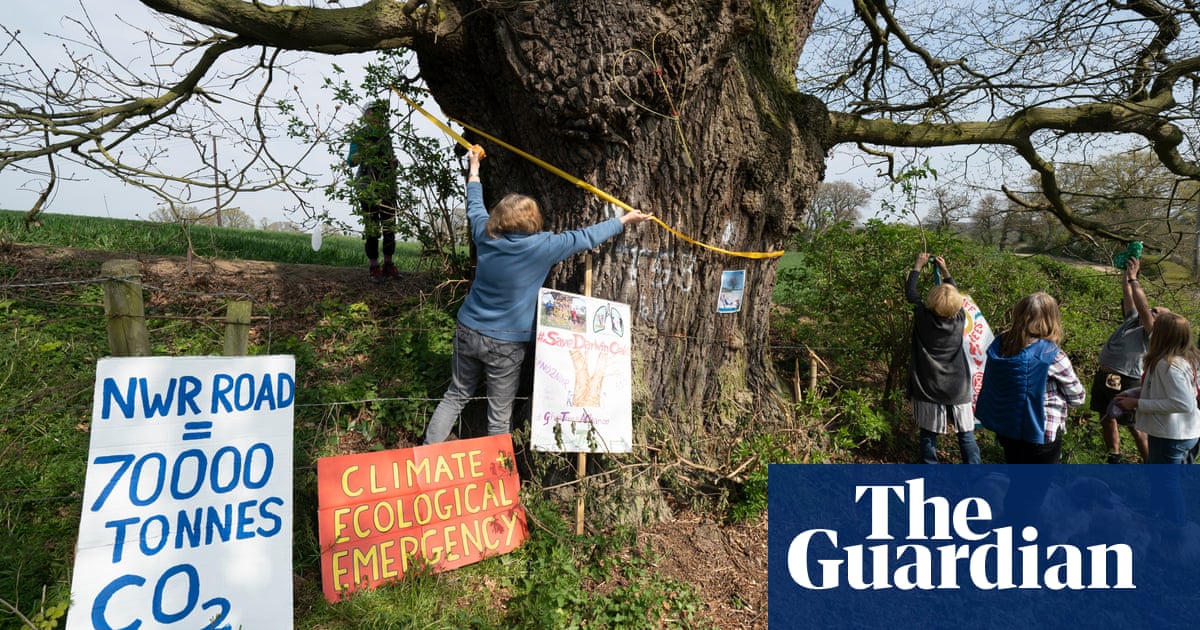
One morning just days after the nation woke to find the Sycamore Gap tree felled by an unknown vandal, Paul Lawrence was walking his dog in a field in East Sussex. His route passed close to a massive and ancient yew, where he had scattered his grandfather’s ashes. Or, at least, close to where the tree used to be.
The yew was still in the field about a mile from Senlac Hill, the generally accepted location of the battle of Hastings. But it now lay on its side, uprooted and dragged about 100 metres from the chasm left when its roots were torn from the ground.
“I was in complete and utter disbelief,” Lawrence, a tree surgeon, told the Argus, a local paper. He believed the yew may have even been old enough to witness the battle.
“The yew is in line with some oaks which are in the 700-year-old age range. I know there was an ancient hedgerow there. This is an ancient marker of an old woodland. This keeps happening and no one seems to do anything,” he said.
The felling of the 300-year-old tree at Sycamore Gap in the Northumberland national park was a catalyst for nationwide sadness. The sudden loss of a tree most people had hitherto not heard of, or only seen in an old Kevin Costner film, plunged people across the country into a feeling of solastalgia – grief at the loss of the natural world.
The Sycamore Gap tree had star power, and its felling ignited a furore. But it was far from the only, or the oldest, or even the most impressive tree recently felled.
In High Wycombe, Buckinghamshire, earlier this month, developers used a digger to tear down trees in woodland behind homes. A resident told local media that one of the men felling the trees had behaved aggressively towards neighbours. The felling continued even after police and council officers arrived, apparently to enforce a tree preservation order on the woodland.
Less than a week later, in Dorset, a community was devastated after an entire wood of thriving conifers, oaks, hornbeams and ash, previously owned by an elderly man, was stripped bare in the space of a day. According to reports, workers even entered neighbours’ gardens and began attacking their trees – then attempted to charge them for the privilege.
“Single acts of vandalism like [Sycamore Gap] are very hard to stop,” says Steve Marsh, a spokesperson for the Woodland Trust.
“But we are losing ancient and veteran trees across the UK most of the time, legally. Right now, most ancient and veteran trees – the ancients of the future – have no real legal protection in the UK.”
For trees, public acclaim is no guarantee of their safety. This week a 480-year-old sweet chestnut in Acton Park, Wrexham was awarded the Woodland Trust’s tree of the year award. But three tree of the year laureates have been cut down in the past three years.
Before the felling of the Sycamore Gap tree, the country had lost – entirely legally – the 250-year-old Cubbington pear, felled in 2020 to make way for HS2, and the Happy Man plane tree in Hackney, the 2020 winner, chopped down the following year for the redevelopment of a housing estate.
That leaves little hope for less well known, but equally ancient, beautiful and ecologically valuable trees when they find themselves in the way of developers’ plans.
The 550-year-old Darwin Oak, along with about 30 other veteran trees, is under threat from plans for a new relief road to the north-west of Shrewsbury, a decision on which is due at the end of the month. Nine veteran trees and some ancient woodland at Ashenbank Wood are slated for the chop to make way for the Lower Thames crossing linking Kent with Essex.
In Norfolk, at least 12 “irreplaceable” trees acknowledged as ancient or veteran are under threat from the Norwich western link road, which was given the go-ahead by ministers just last week.
“The way we designed our legal system is that trees have no standing: they have no legal status, in and of themselves,” says Brontie Ansell, a senior lecturer at Essex Law School and a cofounder of Lawyers for Nature, a legal campaign group advocating for the rights of nature in the UK.
What that means, says Ansell, is that by and large, the rights of life and death over the tree belong to whoever owns the land it is rooted in, with no regard paid to its intrinsic value as a living being or cultural or ecological amenity.
“There is no kind of legal understanding of that tree being a separate legal entity,” she says. “And that’s the case of the vast majority of trees, I’m talking 98% of all trees, they just exist as part and parcel of the land title.”
The exceptions are trees that have been designated as protected by local authorities, by means of tree preservation orders (TPOs). These designations essentially say a public body has ruled that a particular tree has amenity value, beautification value or historical value, and there are – or should be – consequences for cutting it down.
“Now, the issue with that is that it could still be cut down,” says Ansell. “So when you cut the tree down that’s 200 years old, or when you cut a tree down that is so significant, you can send someone to prison, you can fine them three grand, you can publicly shame them, but the tree is still gone.
“Really, what we need is to have a reckoning of our relationship with trees, and how important they are to us [and] our continued success, because at the moment, they are just things that people walk past – and very few people actually genuinely love and adore them and see the value of them.”
It may seem surprising, but the UK is uniquely blessed in Europe with ancient trees. All the experts the Guardian spoke to said it had the most ancient trees of any country in Europe.
But without stronger protections for all trees – not just the most ancient and beautiful – this heritage is at risk, say tree lovers. The Woodland Trust is calling for legal protection for all the country’s oldest and most important trees, something akin to listed building status.
“In a climate and nature emergency the avoidable loss of any old and important trees must be prevented,” says Marsh.
Experts also say the problem is one of succession. Without care for the younger trees we have, we have no hope for ancient trees in the future.
“Planting the tree, the bit where you put it in the ground, is just one part of it – we need to then make sure it gets through to maturity through a process of tree care,” says John Parker, chief executive of the Arboricultural Association.
“And the main thing is, tree maintenance isn’t particularly sexy. Tree planting is sexy, we love saying: ‘Hey let’s plant 10,000 trees.’ But no politician has ever won votes by saying: ‘Next year I’m going to properly mulch 20,000 trees.’”
Humans have not always had such a callous relationship with trees. For millennia, trees have been regarded as intrinsic to the life of the world, and crucial to our future.
In Norse mythology, it is Yggdrasil, the world tree, with its branches in the heavens and its roots in the underworld, which underpins the very existence of all creation. When it dies, the myths tell us, the world dies with it.












